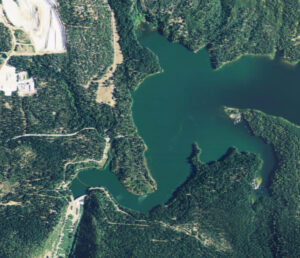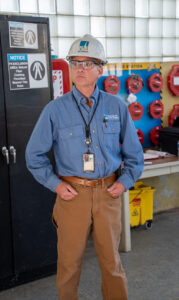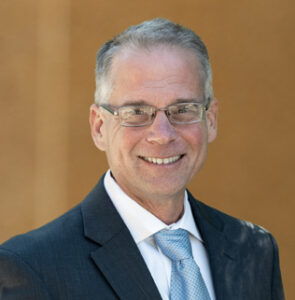The Pacific Gas and Electric Company (PG&E) is a major California utility that serves around 16 million people with a portfolio in which hydropower plays a major role. The supply chain disruptions caused by the COVID‑19 pandemic and the war in Ukraine have caused sudden raw material price increases and availability issues, among other shocks, for PG&E and its suppliers and contractors. PG&E is considering possible responses that range from helping vendors purchase commodities in advance to sourcing more products from the United States. Hydro Leader spoke with Jan Nimick, PG&E’s vice president for power generation, about what the global disruptions mean for California’s largest utility.
Hydro Leader: Please tell us about your background and how you came to be in your current position.
Jan Nimick: I joined the Navy right out of high school as part of its nuclear power program. When I got out of the Navy, I worked as a boiler operator for the State of California while I initially went to college at the California Polytechnic State University, San Luis Obispo. I then started doing some contract work for the local Diablo Canyon nuclear power plant. In 1997, I took a job as a nuclear power plant operator, which was my first full-time job at PG&E. A couple of years later, when I finished my engineering degree, I worked as a senior reactor operator. Eventually, I became the director of operations, then the station director, and then the senior director of engineering, technical, and emergency services. In that position, I was responsible for engineering projects, physical security, cybersecurity, fuels purchasing, fuels storage—basically all the things that support a power plant other than running it. The Camp Fire occurred on November 8, 2018, and the company did a lot of work on the community wildfire safety program. I volunteered for a brief rotation to help out with that work. I spent about 5 months organizing the inspections of all the distribution poles to identify items that needed to be repaired. I am currently PG&E’s vice president of power generation. I am responsible for all the generation that is not nuclear. The hydro fleet has about 160 dams, 100 units at 64 powerhouses, about 150 megawatts (MW) of solar, two combined-cycle units, one reciprocating-engine unit, and a new 180 MW battery storage unit at Elkhorn, which can deliver 4 hours of energy to the grid.
Hydro Leader: What is PG&E’s geographical range, and how many people does it serve?
Jan Nimick: We are the largest utility in California. We serve about 16 million people in a 70,000‑square-mile service area in northern and central California. Our service area reaches Lompoc in Santa Barbara County in the south, nearly to Oregon in the north, and the Sierras in the east. This large area is quite diverse. We serve dense urban communities in the Bay Area; large agricultural interests in the Central Valley; and small rural communities in the eastern part of the state.

Hydro Leader: What percentage of your generation is provided by hydropower?
Jan Nimick: The fraction of our generation that comes from hydro varies widely with the rain year, but it historically averages 31 percent. California’s hydro is unusual in that we have a lot of elevation and not much water. We run our hydro as a dispatchable resource. We have only a few Kaplan turbines and very little generation that I would describe as run of river. The way our hydro facilities are constructed is with a reservoir up high and a diversion through a series of conveyances that take the water down to the powerhouse, which is much lower. Most of our turbines are Pelton turbines, and we run our hydro largely to support the morning and evening peaks of energy demand. That has become increasingly important as more solar has penetrated the market. You’ve got solar generation on the grid, but it doesn’t come on until after the morning peak, and it’s ramping off about the time the evening peak occurs. We handle that peak demand with natural gas imports, combined-cycle plants, and hydro. Given that role, hydro is a renewable resource that enables other renewable resources to operate. The other thing that’s notable about our system is that we have a 1,200 MW pumped storage facility at Helms, which operates between two reservoirs. It has been instrumental in enabling the penetration of solar and wind into the market, since it pumps water when the grid is in overgeneration and saves that potential energy for when it’s needed.
Hydro Leader: How have supply chain disruptions affected your operations?
Jan Nimick: The problems with the supply chain started even before the Russian invasion of Ukraine. During the height of the COVID‑19 pandemic, we had problems getting Carpi liners for dam leakage improvement projects because the materials are shipped in container ships. That was one big material challenge. We had experts from Canada who had a hard time getting into the country because of travel restrictions. We’ve also been seeing shortages of the small-scale transformers that are used to step down from primary to secondary voltage. More recently, since the beginning of the war, the price of steel has been going through the roof. We’re not seeing this yet, but since Russia is a big producer of nickel, we predict that stainless steel will also be much more difficult to come by.
As we try to put contracts in place, it’s difficult for our vendors to price them, because they don’t know what they’re going to be paying for steel or stainless steel when the time comes. We’ve been exploring various ways to address that. We’re looking at whether we can pay more of the contract price up front so that the vendor can obtain materials in advance. We’re also looking at production in the United States and wondering whether we can source more here. Initially, that’s going to cost more, because U.S. labor is more costly. But I think that over time, as U.S. companies see the market coming back to them, there will be more of them, and market forces will help control prices. Our vendors are also looking at markets in Asia. Mostly, I’m thinking of big valves, big components— things that take engineering and have a long wait time. I’m hearing from our vendors that they’re looking at South Korea and Japan, places where they can get a high-quality product. Those are some of the strategies that are being considered to meet these challenges, particularly the price of steel and the uncertainty about future prices.
Hydro Leader: To what degree have your vendors explained to you what they are experiencing?

Jan Nimick: Up to now, our vendors have largely been assuming the risk of price uncertainty. Now, they’re asking us, appropriately, to share that risk. I talked to one vendor who had a quote on obtaining steel that was only good for 30 minutes. He said he’d never heard anything like it before. The supplier told him on the phone, “It will be this much for this quantity, and you’ve got 30 minutes to decide whether you’re going to take it or leave it.” It’s a very unsettled situation. The Wall Street Journal posited that we will be seeing a period of deglobalization in which we’ll look to make supply chains shorter and located more within our borders, with less shipping of things overseas. As a result, prices will go up, but we’ll also see industries that have languished over time be redeveloped in the United States. Maybe we’ll start to see more foundries, steel work, and that kind of thing. We’re going to see rising prices and price uncertainty, at least until the markets catch up with the new reality of uncertain supply chains.
Hydro Leader: Have you delayed or canceled any projects in response to these disruptions?
Jan Nimick: We have considered it, but we haven’t canceled or delayed anything yet. The vendors are asking us to stick with it. We recognize that if we start delaying or canceling projects, it will affect the long-term reliability of our infrastructure. Maybe not today, maybe not next year, but at some point, the grid would become less reliable and more vulnerable because of insufficient generation. The other thing is that if we stop doing projects, then our vendors will have to downsize. They’ll have to lay people off, and those people will go off to other industries. Then, when better times come and we want to ramp up again, our vendors will have a harder time doing that.
Hydro Leader: Obviously, it’s difficult to predict what’s going to happen in situations such as the war in Ukraine. How do you try to plan around that?
Jan Nimick: What is going to occur in Ukraine is hard to predict. Before February 24, I didn’t hear anybody predicting that the Ukrainians would still be in control of their army and retain control of Kyiv after several months. What’s not hard to predict, though, is that this disruption will continue for at least a couple of years. If the war were to stop today, the economy of Ukraine would take a long time to recover. The sanctions against the Russians aren’t going to be lifted anytime soon, either, so the global economy will be in a more difficult place for the foreseeable future. I think we’re going to see simpler but also more expensive supply chains for at least the next 5 years. We just need to plan for that.
Hydro Leader: Is there anything you would like to add?
Jan Nimick: Hydro is a long-term industry. It provides enormous benefit to our communities, our customers, and the people we serve. It takes a long time to build a new project, but the benefits last a long time, too. If any industry should take the long view, it’s us. We need to think about these disruptions in those terms and avoid short-term damage-control decisions that will affect our reliability and our ability to serve our customers and communities in the long term.
Jan Nimick is Pacific Gas and Electric’s vice president for power generation. For more about PG&E, visit pge.com.


